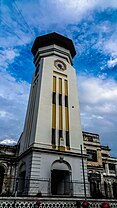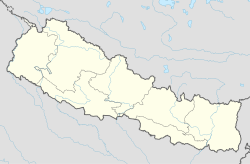
Back Kathmandu ACE Katmandoe Afrikaans ካትማንዱ Amharic Katmandú AN Cæþmandū ANG كاتماندو Arabic كاتماندو ARZ কাঠমাণ্ডু Assamese Katmandú AST काठमाडौं AWA
Kathmandu
काठमाडौँ Kasthamandap, Kantipur, Yen | |
|---|---|
| Kathmandu Metropolitan City | |
Kathmandu's skyline with Gaurishankar visible Boudha Stupa at Boudhanath | |
| Nickname(s): City of Temples[1] मन्दिरहरूको शहर | |
| Motto(s): | |
| Coordinates: 27°43′N 85°19′E / 27.71°N 85.32°E | |
| Country | |
| Province | Bagmati |
| District | Kathmandu |
| Founded by | Manjushri |
| Named for | Kasthamandap |
| No. of Wards | 32 |
| Government | |
| • Type | Mayor–council government |
| • Body | Kathmandu Metropolitan Government |
| • Mayor | Balen Shah (Ind.) |
| • Deputy mayor | Sunita Dangol (UML) |
| • Executive Officer | Pradeep Pariyar[2] |
| Area | |
| • Capital city | 49.45 km2 (19.09 sq mi) |
| • Metro | 899 km2 (347 sq mi) |
| Elevation | 1,400 m (4,600 ft) |
| Population | |
| • Capital city | 856,767 |
| • Rank | 1st |
| • Density | 17,103/km2 (44,300/sq mi) |
| • Metro | Approximately 4 million |
| • Metro rank | 1st |
| Time zone | UTC+05:45 (Nepal Standard Time) |
| Postal Code | 44600 |
| Area code | 01 |
| Website | www |
 | |
Kathmandu,[a] officially the Kathmandu Metropolitan City,[b] is the seat of federal government and the most populous city in Nepal. As of the 2021 Nepal census,[3] there were 845,767 inhabitants living in 105,649 households and approximately 4 million people in its surrounding agglomeration. It is located in the Kathmandu Valley, a large valley surrounded by hills in central Nepal, at an altitude of 4,344 feet (1,324 metres) above sea level.[5]
The city is one of the oldest continuously inhabited places in the world, founded in the 2nd century AD.[6] The valley was historically called the Nepal Mandala (the name for the cosmic elements of water Dha mandala in Newari, and cosmos), and has been the home of the Newar people, a cosmopolitan urban civilization in the Himalayan foothills.[citation needed] The city was the royal capital of the Kingdom of Nepal and hosts palaces, mansions and gardens built by the Nepali aristocracy. It has been home to the headquarters of the South Asian Association for Regional Cooperation SAARC) since 1985.[7] Today, it is the seat of government of the Federal Democratic Republic of Nepal, established in 2008, and is part of Bagmati Province.
Kathmandu is and has been for many years the centre of Nepal's history, art, culture, and economy. It has a multi-ethnic population within a Hindu and Buddhist majority.[8] Religious and cultural festivities form a major part of the lives of people residing in Kathmandu. Tourism is an important part of the economy in the city. In 2013, Kathmandu was ranked third among the top ten upcoming travel destinations in the world by TripAdvisor, and ranked first in Asia. The city is considered the gateway to the Nepal Himalayas and is home to several World Heritage Sites: the Durbar Square, Swayambhu Mahachaitya, Bouddha and Pashupatinath.[9] Kathmandu valley is growing at 4 per cent per year according to the World Bank in 2010,[10] making it one of the fastest-growing metropolitan areas in South Asia, and the first region in Nepal to face the unprecedented challenges of rapid urbanization and modernization at a metropolitan scale.[11] It is the largest metropolitan area located in the Himalayas.
- ^ "All About Kathmandu". February 2022. Archived from the original on 28 September 2023. Retrieved 26 September 2023.
- ^ "Chief Administrative Officer of Kathmandu Metropolitan City". Archived from the original on 21 October 2022. Retrieved 21 October 2022.
- ^ a b "Archived copy" (PDF). cbs.gov.np. Archived from the original (PDF) on 6 February 2022. Retrieved 22 February 2022.
{{cite web}}: CS1 maint: archived copy as title (link) - ^ "Definition of Kathmandu in English". Oxford Dictionaries. Archived from the original on 15 November 2014. Retrieved 13 June 2022.
- ^ "Kathmandu | Rivers, History, Population, Elevation, & Map | Britannica". www.britannica.com. 17 October 2024. Retrieved 29 October 2024.
- ^ Author. "Kathmandu - The Explorers". theexplorers.com. Retrieved 3 October 2024.
{{cite web}}:|last=has generic name (help) - ^ "Nepal and SAARC - Ministry of Foreign Affairs Nepal MOFA". Retrieved 3 October 2024.
- ^ whc.unesco.org https://whc.unesco.org/en/list/121/. Retrieved 3 October 2024.
{{cite web}}: Missing or empty|title=(help) - ^ whc.unesco.org https://whc.unesco.org/en/list/121/. Retrieved 3 October 2024.
{{cite web}}: Missing or empty|title=(help) - ^ "Managing Nepal's Urban Transition". World Bank. Retrieved 3 October 2024.
- ^ "Managing Nepal's Urban Transition". World Bank. Archived from the original on 2 November 2019. Retrieved 1 December 2019.
Cite error: There are <ref group=lower-alpha> tags or {{efn}} templates on this page, but the references will not show without a {{reflist|group=lower-alpha}} template or {{notelist}} template (see the help page).











